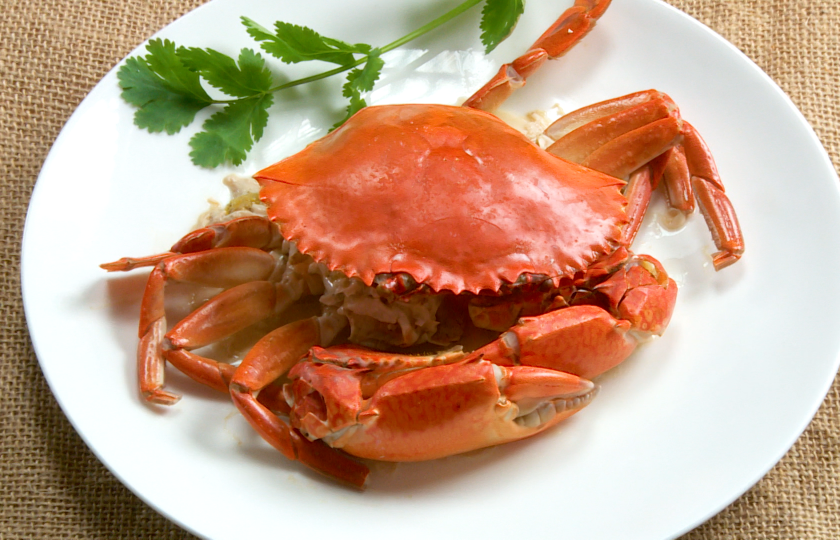Chinese Steamed Crab


No need for excessive seasonings—Chinese Steamed Crab is the best way to highlight its unique, fresh flavor. The meat is tender and delicious with just the right amount of savory taste. One bite, and you'll feel pure happiness.
What is the flavor of Chinese Steamed Crab?
This Chinese steamed crab truly embodies the essence of Cantonese cuisine. The seemingly simple cooking method maximizes the natural sweetness and tender texture of seafood.
Cantonese cuisine emphasizes the authentic flavor of fresh ingredients, and steamed crab perfectly illustrates this philosophy—minimal seasoning while retaining the food’s natural taste.
To recreate this dish at home, ensuring the freshness of the crab is crucial. Do not over-steam; the crab is ready when the meat is fully cooked, and the shell turns bright red, maintaining its original, delicate flavor.

Required Ingredients and Substitutes
Main Ingredients
Crab: Provides tender meat and a fresh seafood flavor, which is the core ingredient of the dish.
Side Ingredients
Ginger: Adds a spicy aroma and helps remove fishy odors, enhancing the flavor.
Green onions: Contributes a fresh fragrance, balancing the overall flavor.
Seasonings
Chinese black vinegar: Adds acidity and flavor, enhancing the overall taste.
Cooking wine: Removes fishy odors and adds fragrance.
Substitutes
Crab: Can be replaced with other seafood such as lobster or shrimp, though the flavor will differ.
Chinese black vinegar: Can be replaced with white vinegar or apple cider vinegar, with a slight difference in taste.
Cooking wine: Can be replaced with white wine or dry white wine, providing a similar effect in removing fishy odors.
What tools do you need?
Steamer
A steamer is the essential tool for steaming crabs. It provides even heat distribution, ensuring the crabs are fully cooked while retaining their freshness and flavor.
Steaming Rack
If using a traditional steamer, the rack prevents the crab from directly touching the water at the bottom of the pot. This ensures the crabs are heated by steam rather than boiled, preserving their natural taste. If you don’t have a steaming rack, alternatives such as a heat-resistant plate or other sturdy kitchen tools can work.
Tongs
Tongs are incredibly useful for handling crabs after steaming. They allow you to safely remove the crabs without burning yourself or breaking the delicate shells. Using tongs also ensures the crabs stay intact, especially for presentation in dishes like this, where aesthetics matter.
Which crabs are suitable for steaming?
Flower Crabs
These crabs have tender meat and a naturally sweet flavor, making them ideal for steaming. Rich in crab roe and with a plump texture, they are perfect for those who enjoy mild and clean flavors. For seafood lovers who appreciate natural taste, flower crabs are an excellent choice.
Hairy Crabs
A classic choice for steaming, especially during autumn and winter. Hairy crabs have delicate meat and rich roe, with a flavor that becomes even more intense after steaming. The abundance of crab roe offers a taste that feels like a gift from nature, perfect for roe enthusiasts.
Mud Crabs
Best enjoyed in spring and autumn, mud crabs have firm meat with a fresh and slightly robust flavor. After steaming, they release a rich aroma and offer a chewy texture, suitable for those who prefer a firmer bite.
Swimming Crabs
Commonly found in seafood markets, these crabs have plump and delicate meat. Steamed swimming crabs offer a sweet taste and are rich in roe. A simple ginger and scallion dip enhances their natural flavor, making them ideal for family gatherings.
Roe Crabs
These crabs are characterized by their abundant roe and glossy yellow hue. The roe becomes especially fragrant and flavorful after steaming. For seafood lovers seeking a high-quality delicacy, roe crabs are a must-try treat.
INGREDIENTS
Main Ingredients
-
·1 whole fresh crab
Additional Ingredients
-
·20g ginger
-
·20g green onions
Seasonings
-
·30ml Chinese black vinegar
-
·Few drops cooking wine
COOKING STEP
Step 1
Clean the crab, remove the innards, and rinse thoroughly. Lightly tap the crab claws and plate it for later use.

Step 2
Slice 20g of ginger into strips and cut a small portion into slices. Cut 20g of green onions into two sections for later use.

Step 3
Prepare the dipping sauce: In a small dish, pour 30ml of Chinese black vinegar and add the ginger strips, then stir.

Step 4
In a pot, add warm water and place the crab in a steaming rack. Add the ginger slices, green onion sections, and a few drops of cooking wine.

Step 5
Cover the pot and steam for 12-15 minutes.

Step 6
Once done, remove the crab from the pot, discard the ginger slices and green onion sections, and the dish is ready to serve.

More recipes worth trying
Delicious Steamed Grouper Fish Recipe
Exquisite Steamed Shrimp with Vermicelli Recipe
Serving Suggestions
Dip Pairing: The classic ginger and black vinegar dipping sauce is refreshing and enhances the crab's natural flavor. For a richer taste, add a bit of soy sauce or minced garlic to the vinegar for a multi-layered flavor experience.
Side Dishes: Since Chinese Steamed Crab has a light flavor, pairing it with refreshing side dishes like pickled vegetables, cucumber salad, or stir-fried greens can balance the meal and provide a delightful variety of textures and colors.
Wine Pairing: To elevate the dining experience, pair with white wine, sake, or Shaoxing wine. These options complement the crab's freshness and create a refined taste balance, especially for gatherings or special occasions.
Eating Order: When enjoying the crab, start with the meat and save the crab roe for last. The roe is the richest and most flavorful part, leaving a lasting impression. Gently crack the shell and savor the process, ensuring every bite is a memorable experience.
Clean Eating: Prepare napkins or wet wipes to handle potential mess. Take your time to open the crab shell carefully, making the meal more enjoyable and less messy.
FAQs:
Remove the internal organs, leaving the roe or crab fat if preferred.
For the legs, pull them apart by hand and use chopsticks or a fork to extract the meat.
For the body, scrape the meat out with a fork—it’s simple and efficient.
Turn the crab over and lift the small abdominal flap, scrubbing it gently, especially around crevices.
Wash the legs and claws thoroughly, paying attention to any gaps where dirt may accumulate.
Lastly, remove the gills inside the crab body, as these are inedible. A soft brush can help clean the shell and legs effectively.
Take the crab out of the freezer and let it thaw in the refrigerator to avoid drastic temperature changes that affect the texture.
If you’re short on time, you can thaw the crab in cold water, but steaming it straight from frozen is not recommended.
Once thawed, steam the crab for 12-15 minutes, adjusting the time based on the crab’s size.
This ensures tender meat and an optimal flavor.
It preserves the crab’s natural sweetness and keeps the texture tender and juicy.
Steaming also prevents the crab shells from becoming too loose, which helps retain the firmness of the meat.
While boiling is common, it may result in some loss of flavor to the water and can make the meat softer.
For the purest and most enjoyable crab taste, steaming is the superior method.

















